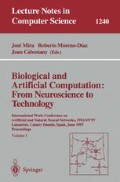Abstract
In the classical neuron model inputs are continuous real-valued quantities. However in many important domains from the real world, objects are described by a mixture of continuous and discrete variables and usually containg missing information. A general class of neuron models accepting heterogeneous inputs in the form mixtures of continous and discrete quantities admiting missing data is presented. From these, several particular models can be derived as instances and also different neural architectures can be constructed with them. In particular, hybrid feedforward neural networks composed by layers of heterogeneous and classical neurons are studied here, and a training procedure for them is constructed using genetic algoritmhs. Their possibilities in solving classification and diagnostic problems are illustrated by experiments with data sets from known repositories. The experiments shows that these networks are robust and that they can both learn and classify complex data very effectively and without preprocessing or variable transformations, also in the presence of missing information.
Preview
Unable to display preview. Download preview PDF.
References
Baker, J.E.: Adaptative selection methods for genetic algorithms. In J.J. Grefenstette, editor, Proceedings of the First International Conference on Genetic Algorithms, Lawrence Erlbaum Associates, (1985), 101–111.
Baker, J.E.: Reducing Bias and Inefficiency in the Selection Algorithm. In J.J. Grefenstette, editor, Proceedings of the Second International Conference on Genetic Algorithms, Lawrence Erlbaum Associates, (1987), 14–21.
Beasey, D.; Bull, D.R.; Martin, R.R.: An Overview of Genetic Algorithms: Part1, Fundamentals. University Computing, 15(2), (1993) 58–69.
Bishop, C.M.: Neural Networks for Pattern Recognition. Oxford University Press, (1995).
Chandon, J.L, Pinson, S: Analyse Typologique. Théorie et Applications. Masson, (1981), 254.
Davis, L.D.: Handbook of Genetic Algorithms. Van Nostrand Reinhold, (1991).
Fukunaga, K.: Introduction to Statistical Pattern Recognition (Second Ed.) San Diego: Academic Press, (1990).
Goldberg, D.E.: Genetic Algorithms for Search, Optimization & Machine Learning. Addison-Wesley, (1989).
Gower, J.C.: A General Coefficient of Similarity and some of its Properties. Biometrics 27, (1971), 857–871.
Ingber, A.L.: Very Fast Simulated Annealing. Jour. Math. Comp. Modeling. 12, (1989) 967–973.
Prechelt, L.;: Proben1: A Set of Neural Network Benchmark Problems and Bench-arking Rules. Fakultät für Informatik. Universität Karlsruhe, Germany. Technical Report 21/94, ftp://ftp.ira.uka:/pub/neuron, (1994).
Rutenbar, R. A.: Simulated Annealing Algorithms: An overview. IEEE Circuits and Devices Mag. Jan. (1989) 19–26.
Author information
Authors and Affiliations
Editor information
Rights and permissions
Copyright information
© 1997 Springer-Verlag Berlin Heidelberg
About this paper
Cite this paper
Valdés, J.J., García, R. (1997). A model for heterogeneous neurons and its use in configuring neural networks for classification problems. In: Mira, J., Moreno-Díaz, R., Cabestany, J. (eds) Biological and Artificial Computation: From Neuroscience to Technology. IWANN 1997. Lecture Notes in Computer Science, vol 1240. Springer, Berlin, Heidelberg. https://doi.org/10.1007/BFb0032481
Download citation
DOI: https://doi.org/10.1007/BFb0032481
Published:
Publisher Name: Springer, Berlin, Heidelberg
Print ISBN: 978-3-540-63047-0
Online ISBN: 978-3-540-69074-0
eBook Packages: Springer Book Archive

